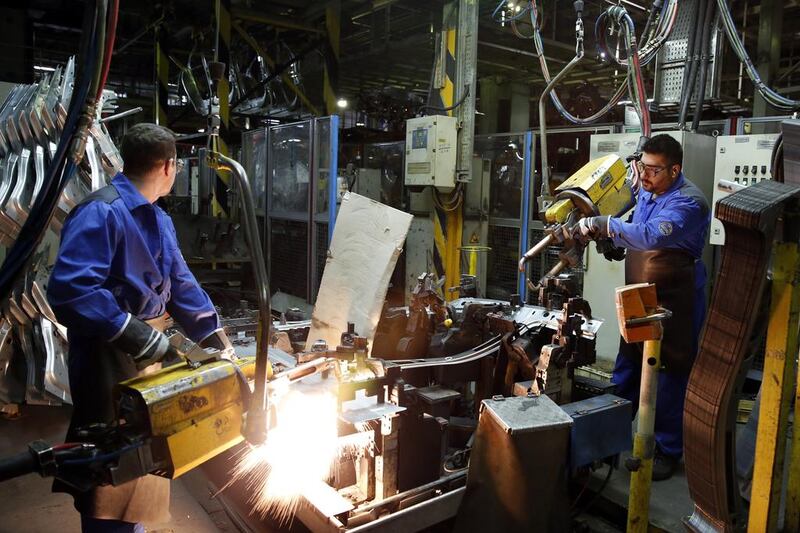TEHRAN // When Alireza Amoei’s new car finally arrived, a year late, it was missing a few parts.
There was no spare tyre and no stereo. He complained to the company from which he ordered his Peugeot 206, Iran Khodro, the largest automobile manufacturer in the Middle East. After much back and forth, he was told last month the parts were not available.
“The only excuse for such a long delay in delivery was lack of parts due to sanctions,” said the 41-year-old physician, as he refilled in a Tehran petrol station.
Iran once had a vibrant car culture, but years of international sanctions have had a devastating effect on the local automobile industry. Production has dropped by more than half since 2011 — down to 626,110 vehicles in 2013 compared to 1.6 million two years earlier.
This week the industry was dealt a further blow with the announcement that long-standing energy subsidies would be reduced dramatically and petrol prices would rise. As a result, Iran Khodro has temporarily halted sales until the new prices are confirmed.
Iranians have a deep affinity for cars and they have long featured prominently in popular and political culture.
The Shah, deposed in 1979, had a large collection of vintage and classic vehicles including a 1960 Plymouth XNR which sold for US$935,000 at a California car auction in 2012.
The former president, Mahmoud Ahmadinejad, drove a 1977 Peugeot 504, in an effort to portray himself as a man of the people. In 2011, he auctioned the car for $2.5 million to raise money for a housing charity.
Cars were already expensive when international sanctions in response to Iran’s nuclear programme hit its automotive industry two years ago. The sanctions were introduced under the pretext that auto parts might be used to produce military equipment — a charge Iran denies.
The sanctions caused several of Iran’s foreign automotive partners to exit the Iranian market.
The French motoring giant PSA Peugeot Citroen, a long-time partner of Iran Khodro, suspended sales to Iran in February 2012. At the time Iranians were the second largest Peugeot customers in the world with the vehicles built in Iran Khodro’s factories.
The departure of foreign firms forced Iranian car makers to quickly become self-sufficient.
“When Peugeot first left, we froze. It took us a year to produce our first Iranian part,” said Farzad Mansouri, the head of the assembly line of the Peugeot 206. “It was not easy. It was a disaster for us. But now we are completely independent.”
Today, Iran Khodro manufactures all automobile parts that PSA Peugeot Citroen used to supply, a source of great pride for the workers.
Despite the firm’s best efforts, Iran Khodro, which controls half of the country’s domestic car market, has seen passenger car production dramatically decline over the last three years.
The number of vehicles sold dropped from 773,000 in the year ending March 2012 to 448,000 the following year.
Sales this year are likely to be further hampered after the announcement of the fuel subsidy cuts as the government tries to boost the struggling Iranian economy.
Iran Khodro, which also produces the Runna and Samand vehicles, said it will wait to hear the new petrol price before it starts selling its vehicles again.
On a recent visit to the Iran Khodro factory in west Tehran rows and rows of new cars were lined up outside waiting for customers.
“Three years ago the number of cars parked here was twice as much and workers didn’t have a minute to rest, but now both production and sales have slowed down,” said Hossein Ranjbar, a plant manager.
At its peak, Iran Khodro, exported cars to 25 countries and had assembly factories in Azerbaijan, Belarus, Syria, Venezuela, Senegal and Iraq. It provided jobs for 37,000 workers in its production plants in Iran, with another 15,000 working in related facilities.
Despite the tough times caused by the sanctions, Iran Khodro said it has managed to avoid cutting jobs
Today, there a total of 37,000 workers work in Tehran’s factory.
But Iran Khodro’s attempts to produce all its own parts has come at a cost.
As the prices have increased there have been quality issues and certain parts are not always available.
“The prices of Iran Khodro cars tripled in less than two years, but look at the quality. The front door doesn’t shut properly,” said a taxi driver named Manuchehr, 65, who drives Khodro-built Peugeot 405.
Executives at Iran Khodro said they hope the temporary removal of sanctions on the auto sector, part of an interim deal between Tehran and world powers over its nuclear programme, will help revitalise the industry. Talks are currently underway on how to make that deal permanent.
Iran Khodro is currently negotiating the return of some of the biggest global names in car manufacturing, such as Suzuki and Mercedes, along with Peugeot. And there is even a possibility that American car producers will enter the market.
After surviving its toughest days Iran’s auto industry is preparing itself for a better future, but that is only likely to happen if foreign investors return.
“The path for investment of European companies has been paved and they are ready to come back,” said Hasan Bananej, international relations manager at Iran Khodro.
“Foreign investment always goes to countries that appear stable and finally the international community is starting to understand that Iran is not dangerous.”
foreign.desk@thenational.ae





